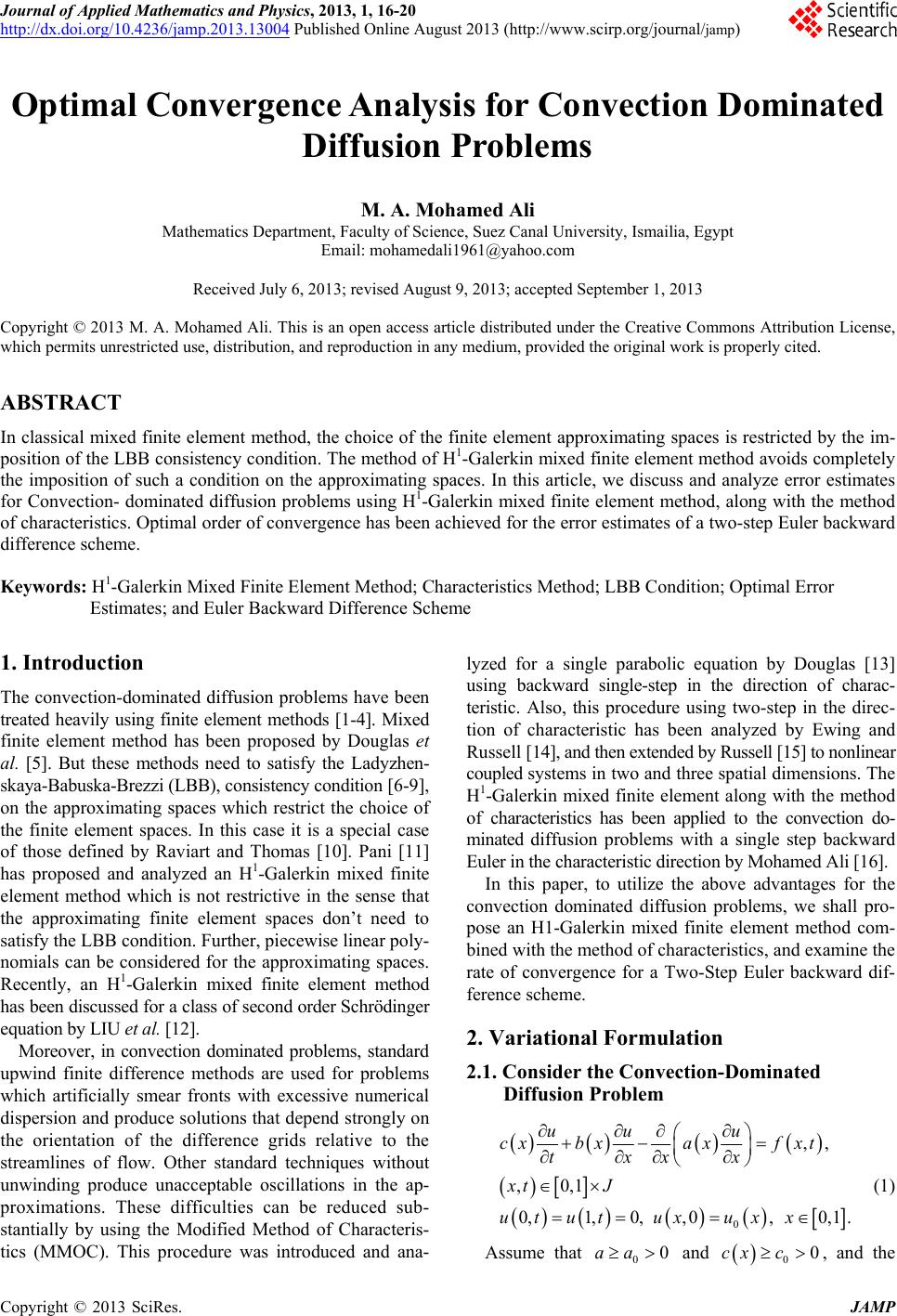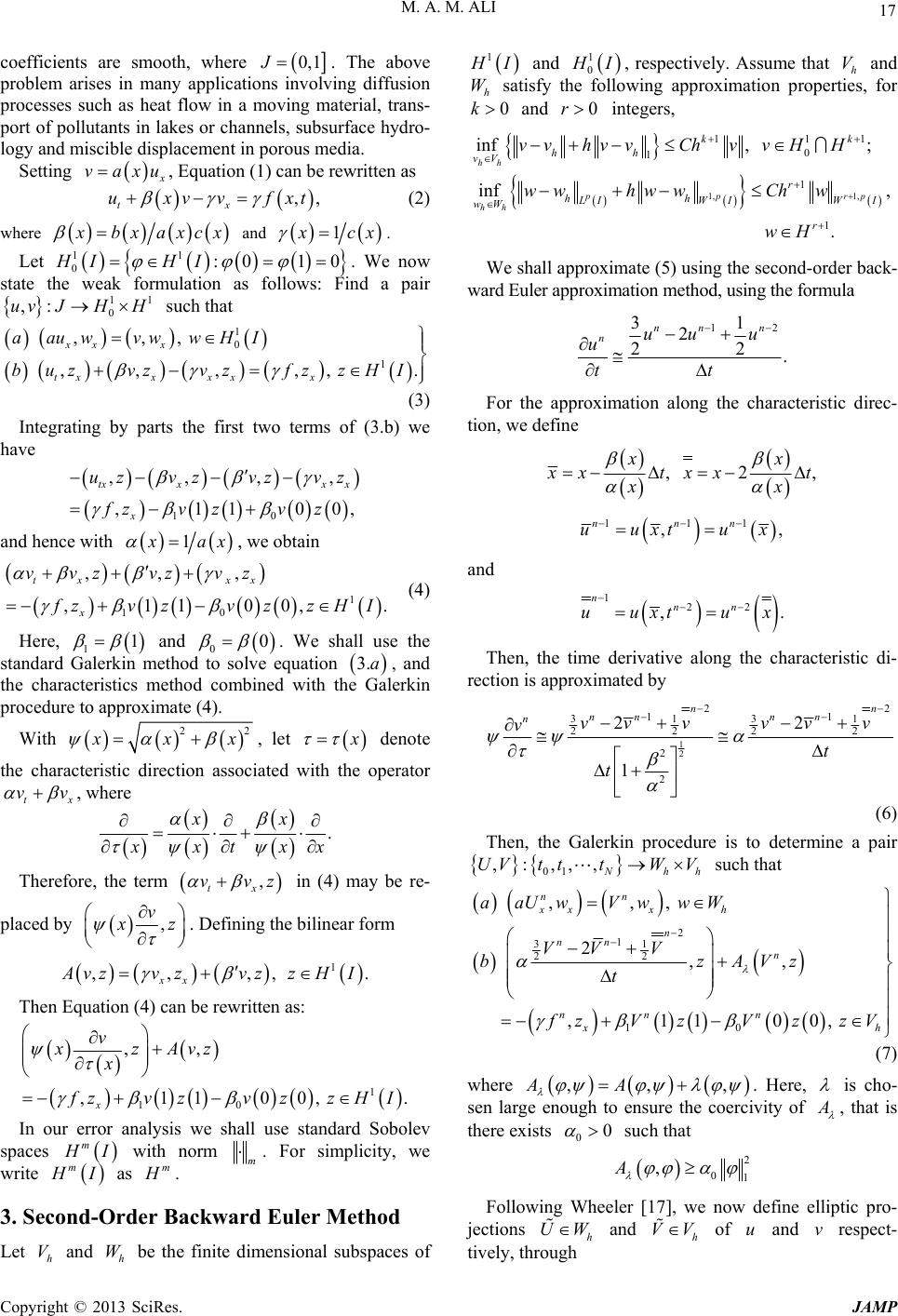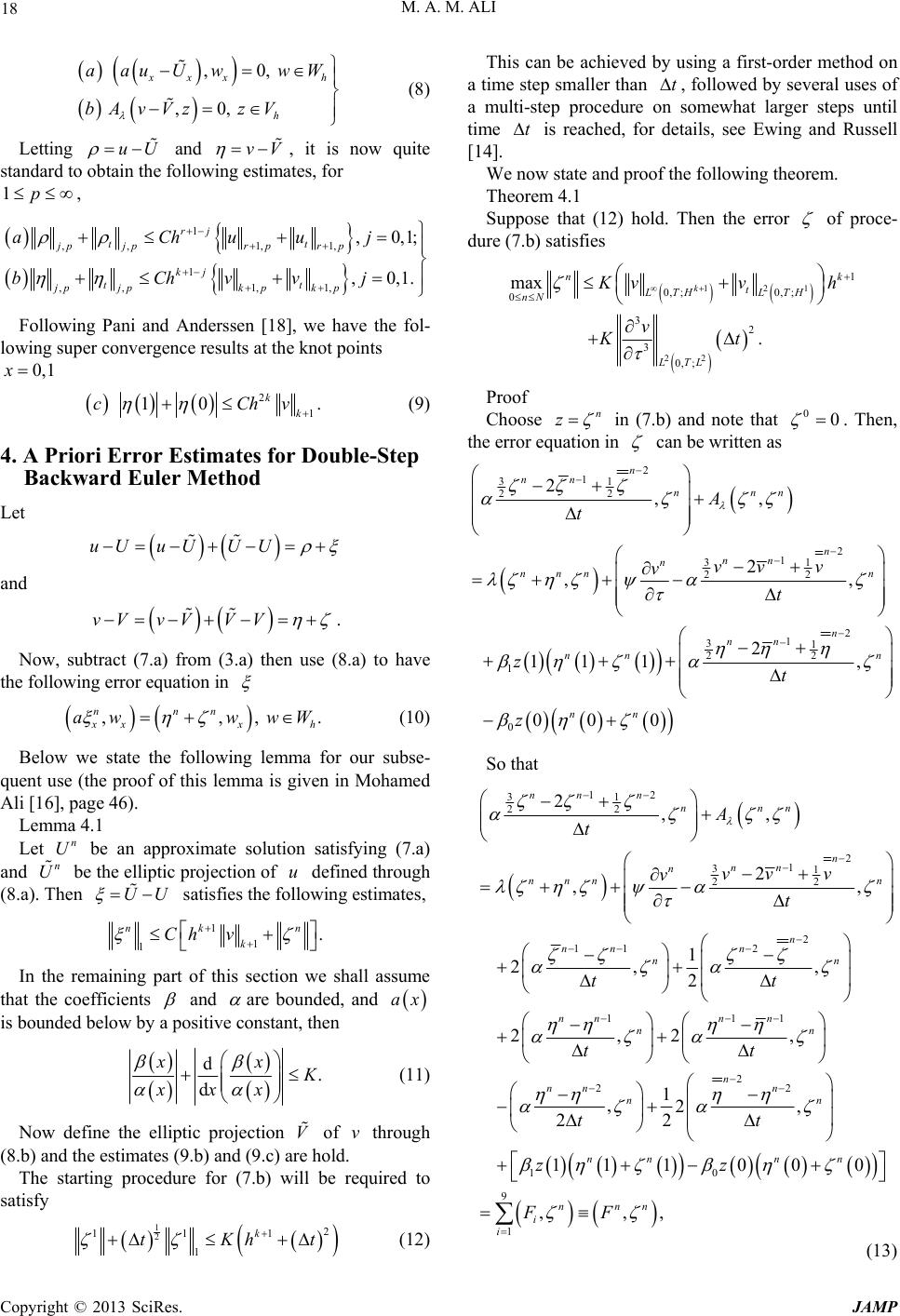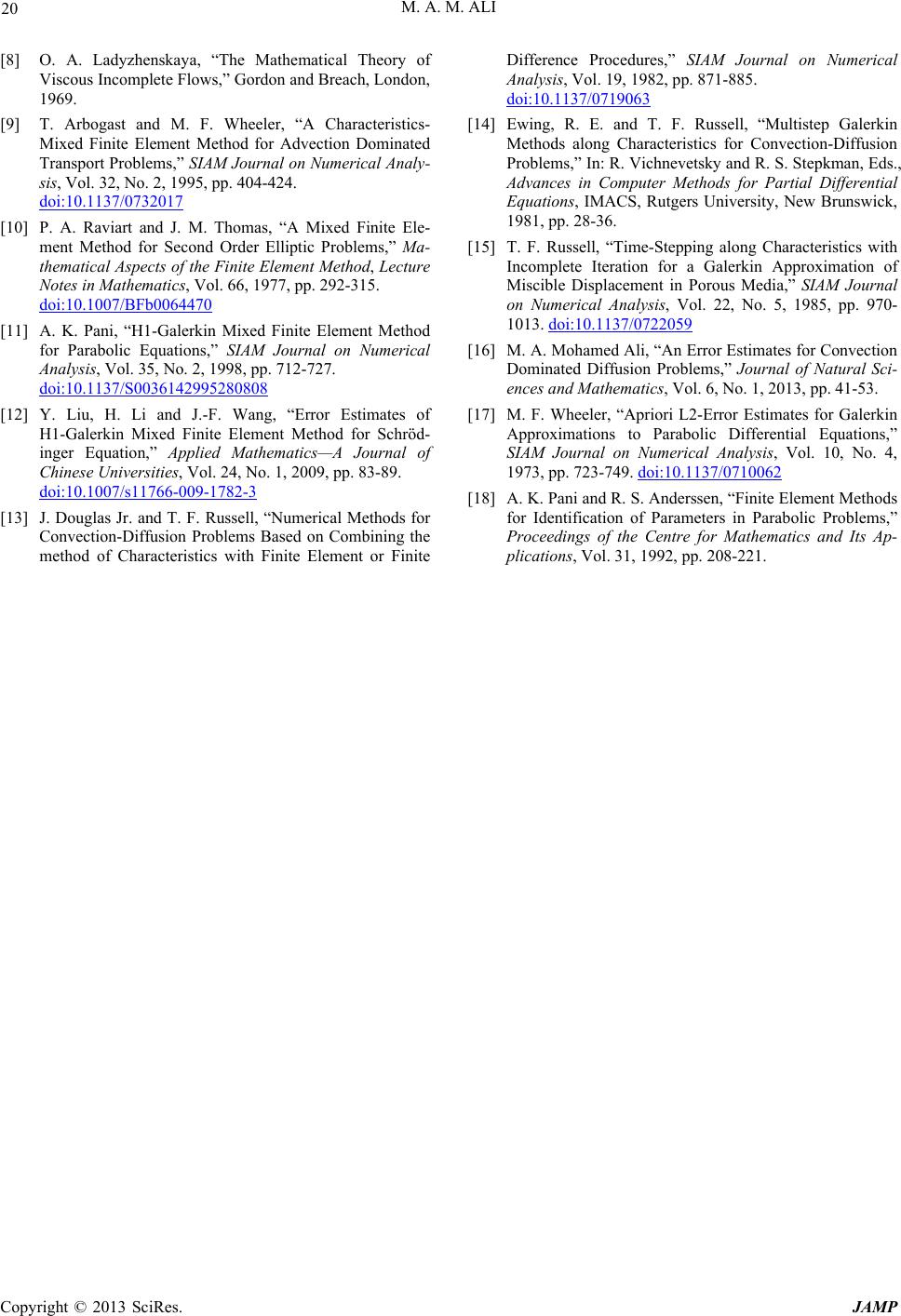 Journal of Applied Mathematics and Physics, 2013, 1, 16-20 http://dx.doi.org/10.4236/jamp.2013.13004 Published Online August 2013 (http://www.scirp.org/journal/jamp) Optimal Convergence Analysis for Convection Dominated Diffusion Problems M. A. Mohamed Ali Mathematics Department, Faculty of Science, Suez Canal University, Ismailia, Egypt Email: mohamedali1961@yahoo.com Received July 6, 2013; revised August 9, 2013; accepted September 1, 2013 Copyright © 2013 M. A. Mohamed Ali. This is an open access article distributed under the Creative Commons Attribution License, which permits unrestricted use, distribution, and reproduction in any medium, provided the original work is properly cited. ABSTRACT In classical mixed finite element method, the choice of the finite element approximating spaces is restricted by the im- position of the LBB consistency cond ition. The method of H1-Galerkin mixed finite element method avoids completely the imposition of such a condition on the approximating spaces. In this article, we discuss and analyze error estimates for Convection- dominated diffusion problems using H1-Galerkin mixed finite element method, along with the method of characteristics. Optimal order of convergence has been achieved for the error estimates of a two-step Euler backward difference scheme. Keywords: H1-Galerkin Mixed Finite Element Method; Characteristics Method; LBB Condition; Optimal Error Estimates; and Euler Backward Difference Scheme 1. Introduction The convection-dominated diffusion problems have been treated heavily using finite element methods [1-4]. Mixed finite element method has been proposed by Douglas et al. [5]. But these methods need to satisfy the Ladyzhen- skaya-Babuska-Brezzi (LBB), consistency condition [6-9] , on the approximating spaces which restrict the choice of the finite element spaces. In this case it is a special case of those defined by Raviart and Thomas [10]. Pani [11] has proposed and analyzed an H1-Galerkin mixed finite element method which is not restrictive in the sense that the approximating finite element spaces don’t need to satisfy the LBB condition. Further, piecewise linear poly- nomials can be considered for the approximating spaces. Recently, an H1-Galerkin mixed finite element method has been discussed for a class of second order Schrödinger equation by LIU et al. [12]. Moreover, in convection dominated problems, standard upwind finite difference methods are used for problems which artificially smear fronts with excessive numerical dispersion and produce solutions that depend strongly on the orientation of the difference grids relative to the streamlines of flow. Other standard techniques without unwinding produce unacceptable oscillations in the ap- proximations. These difficulties can be reduced sub- stantially by using the Modified Method of Characteris- tics (MMOC). This procedure was introduced and ana- lyzed for a single parabolic equation by Douglas [13] using backward single-step in the direction of charac- teristic. Also, this procedure using two-step in the direc- tion of characteristic has been analyzed by Ewing and Russell [14], and the n exte nde d by R ussel l [1 5] to nonli ne ar coupled systems in two and three spatial d imensions. The H1-Galerkin mixed finite element along with the method of characteristics has been applied to the convection do- minated diffusion problems with a single step backward Euler in the characteristic direction by Mohame d Ali [16] . In this paper, to utilize the above advantages for the convection dominated diffusion problems, we shall pro- pose an H1-Galerkin mixed finite element method com- bined with the method of characteristics, and examine the rate of convergence for a Two-Step Euler backward dif- ference scheme. 2. Variational Formulation 2.1. Consider the Convection-Dominated Diffusion Problem 0 ,, ,0,1 0,1,0,,0, 0,1. uu u cxbxaxf xt txxx xt J ututux uxx (1) Assume that and , and the 00aa 00cx c C opyright © 2013 SciRes. JAMP  M. A. M. ALI 17 coefficients are smooth, where 0,1J. The above problem arises in many applications involving diffusion processes such as heat flow in a moving material, trans- port of pollutants in lakes or channels, subsurface hydro- logy and miscible displacement in porous media. Setting vaxu ux , Equation (1) can be rewritten as ,, x fxt t vv (2) where bx axcx and 1 cx . Let 1 11 0:0 0HI HI 11 0 JH H . We now state the weak formulation as follows: Find a pair such that ,:uv , , x I fz 0 1 ,,, ,,, xx x txx xx aauw vwwH buzvzvzzHI 1 . (3) Integrating by parts the first two terms of (3.b) we have 10 , 1 x vz v z ,, , ,1 0 tx xx x uz vzvz fzv z 0, and hence with 1 ax , we obtain 1 10 ,, ,11 , tx x x vvzvz v , 00 x z . zvz zHI vz 0 (4) Here, and 0. We shall use the standard Galerkin method to solve equation , and the characteristics method combined with the Galerkin procedure to approximate (4). 11 3.a With 22 xx , let denote the characteristic direction associated with the operator t vv x , where . xx xt xx Therefore, the term in (4) may be re- placed by , tx vvz , v z . . Defining the bilinear form 1 ,,,, xx vzv zvzzHI Then Equation (4) can be rewritten as: 1 10 ,, ,1100, x v xzAvz x . zvz vzzHI In our error analysis we shall use standard Sobolev spaces m I with norm m . For simplicity, we write m I as m . 3. Second-Order Backward Euler Method Let and be the finite dimensional subspaces of h Vh W 1 I and 1 0 I 0r , respectively. Assume that h and satisfy the following approximation properties, for and integers, V h W0k 1,1, 11 0 1 1 1 inf, ; inf , . hh rppp hh kk hh vV r hh WILIW I wW r vvhvvChvvH H wwhwwChw wH 1 We shall approximate (5) using the second -order back- ward Euler approximati on method, using the f orm ula 12 31 2 22 . nn n nuu u u tt For the approximation along the characteristic direc- tion, we define , 2, xx xtxx xx t 111 ,, nnn uuxtux and 122 ,. nnn uuxtux Then, the time derivative along the characteristic di- rection is approximated by 1 2 22 11 33 11 222 2 2 22 1 nn nn nn nvvvvv v v t t 2 (6) Then, the Galerkin procedure is to determine a pair 01 ,:,,, hh UVt ttWV such that 2 1 31 22 10 ,,, 2 ,, ,1100, nn xxx h n nn n nnn h aaUw VwwW VV V bzAVz t zVz VzzV (7) where ,,AA , . Here, is cho- sen large enough to ensure the coercivity of , that is there exists 00 such that 2 01 ,A Following Wheeler [17], we now define elliptic pro- jections and h UW h VV of and respect- tively, through u v Copyright © 2013 SciRes. JAMP  M. A. M. ALI 18 ,0, ,0, xx h h aauUw wW bAvVz zV (8) Letting and uU vV , it is now quite standard to obtain the following estimates, for , 1p 1 ,1, ,1, 1 ,1,,1, ,0,1; ,0,1. rj tt jpr p jpr p kj tt jpk pjpkp aChuu bChvvj j Following Pani and Anderssen [18], we have the fol- lowing super converg ence results at the knot points 0,1x 2 1 10k k cCh .v (9) 4. A Priori Error Estimates for Double-Step Backward Euler Method Let uU uUUU and vV vVVV . Now, subtract (7.a) from (3.a) then use (8.a) to have the following error equation in ,,, nnn . xx aw wwW h (10) Below we state the following lemma for our subse- quent use (the proof of this lemma is given in Mohamed Ali [16], p age 46) . Lemma 4.1 Let be an approximate solution satisfying (7.a) and be the elliptic projection of defined through (8.a). Then satisfies the following estimates, n U n Uu UU 1 1 1. nk k Chv n In the remaining part of this section we shall assume that the coefficients and are bounded, and ax is bounded below by a positive constant, then d. d xx xxx (11) Now define the elliptic projection of through (8.b) and the estimates (9.b) and (9.c) are hold. V v The starting procedure for (7.b) will be required to satisfy 1 22 111 1 k tKh This can be achieved by using a first-order method on a time step smaller than t , followed by several uses of a multi-step procedure on somewhat larger steps until time t is reached, for details, see Ewing and Russell [14]. We now state and proof the following theorem. Theorem 4.1 Suppose that (12) hold. Then the error of proce- dure (7.b) satisfies 121 22 1 0, ;0, ; 0 32 3 0, ; max . k nk t LTHLTH nN LTL vv v Kt h Proof Choose n z in (7.b) and note that 00 . Then, the error equation in can be written as 2 1 31 22 2 1 31 22 2 1 31 22 1 0 2,, 2 ,, 2 11 1, 00 0 n nn nnn n nn n nnn n n nn nn nn A t vvv v t zt z n So that 12 31 22 2 1 31 22 2 11 2 111 2 2,, 2 ,, 1 2, , 2 2,2, , 2 nn n nnn n nn n nnn n n nn n nn nnn n nn nn n A t vvv v t tt tt t 22 10 9 1 12, 2 1110 00 ,,, nnn nnn n nnn i i t zz FF (13) t (12) Copyright © 2013 SciRes. JAMP  M. A. M. ALI 19 To treat the left hand side of (13), we use the following stability lemma. Lemma 4.2 If (12) and (13) hold, then for , 2lN 11 2 4 122 2 41 ,,, 33 4,2 3 l llnnl l n lnll k n At tKh t (14) For proof of this lemma, refer to R.E Ewing and Russell [14]. By the lemma 4.2, theorem 4.1, will be proved if we can handle the terms on the right-hand side of (14). The first term can be ignored because of the coefficient 1 3; a recursion argument would sho w that it could be removed if the other terms were multiplied by 23 11 13 3 2 . For the second term, expressions of the forms 2 1 nt and 2 n t can be respectively hidden on the left-hand side of (13) and eliminated by the discrete Gronwall’s lemma. Hence, using (9.b), the first term on the right hand side o (13) can be handled as: 22 22 1 1 , nnn n k k Kh v . I.e., 1 22 22 10, ; 2 k lnk LTH n FtKhv (15) and as in Ewing and Russell [14], the following terms on the right- h and side o f (13) is bounded by 22 2 3 24 23 20, ; ln nLTL v tK t , (16) 2 1 31 22 ll nn nn 2 t t , (17) 2 2 4 22 ll nn nn 2 t t, (18) 2 22 22 50, ; 2 k lnk tLTH n FtKhu , (19) 1 22 22 60, ; 2 k lnk LTH n FtKhv , (20) 2 22 22 70, ; 2 k lnk tLTH n FtKhu , (21) 1 22 22 80, ; 2 k lnk LTH n FtKhv , (22) and as in Mohamed Ali [16], the last term is bounded by (23) 1 22 4 90, ; 2 k lnk LTH n FtKhv Inserting these results in (14) completes the proof of the theorem. 5. Conclusion The computational process of the classical mixed finite element methods faces some difficulties while choosing the finite element spaces due to the restrictive LBB con- dition which is a must for such methods. In this paper, the application of this condition has been avoided by using the H1-Galerkin mixed finite element method. For more accurate and fast results, we have used the mo- dified characteristics method for two-step backward euler time discretization. This allows choosing the finite ele- ment spaces freely and maintaining the optimality of the order of convergence of the analysis. This problem has a wide range of applications in the real life such as in the transport of air and water pollutants, in oil reservoir flow, in the modeling of semiconductor and so forth. REFERENCES [1] A. C. Galeao, R. C. Almeida, S. M. C. Malta and A. F. D. Loula, “Finite Element Analysis of Convection-Domi- nated Reaction-Diffusion Problems,” Applied Numerical Mathematics, Vol. 48, No. 2, 2004, pp. 205-222. doi:10.1016/j.apnum.2003.10.002 [2] M. El-Amrani and M. Seaid, “A Finite Element Modified Method of Characteristics for Convection Heat Trans- port,” Numerical Methods for Partial Differential Equa- tions, Vol. 24, No. 3, 2008, pp. 776-798. doi:10.1002/num.20288 [3] F. Freiberger, “Numerical Solution of Convection- Do- minated Problems Using Isogeometric Analysis,” Insti- tute fur Mathematik, TU Clausthal, Clausthal-Zellerfeld, 2010. [4] J. Volker and N. Julia, “Error Analysis of the SUPG Fi- nite Element Discretization of Evolutionary Convection- Diffusion-Reaction Equations,” SIAM Journal on Nu- merical Analysi s, Vol. 49, No. 3, 2011, pp. 1149-1176. [5] J. Douglas Jr., R. E. Ewing and M. F. Wheeler, “A Time- Discretization Procedure for a Mixed Finite Element Ap- proximation of Miscible Displacement in Porous Media,” ESAIM: Mathematical Modelling and Numerical Analysis: Modélisation Mathématique et Analyse Numérique, Vol. 17, No. 3, 1983, pp. 249-265. [6] I. Babuska, “The Finite Element Method with Lagrange Multipliers,” Numerische Mathematik, Vol. 20, No. 3, 1973, pp. 179-192. doi:10.1007/BF01436561 [7] F. Brezzi, “On the Existence, Uniqueness and Approxi- mation of Saddle Point Problems Arising from Lagrange Multipliers”, ESAIM: Mathematical Modelling and Nu- merical Analysis: Modélisation Mathématique et Analyse Numérique, Vol. 8, No. 2, 1974, pp. 129-151. Copyright © 2013 SciRes. JAMP  M. A. M. ALI Copyright © 2013 SciRes. JAMP 20 [8] O. A. Ladyzhenskaya, “The Mathematical Theory of Viscous Incomplete Flows,” Gordon and Breach, London, 1969. [9] T. Arbogast and M. F. Wheeler, “A Characteristics- Mixed Finite Element Method for Advection Dominated Transport Problems,” SIAM Journal on Numerical Analy- sis, Vol. 32, No. 2, 1995, pp. 404-424. doi:10.1137/0732017 [10] P. A. Raviart and J. M. Thomas, “A Mixed Finite Ele- ment Method for Second Order Elliptic Problems,” Ma- thematical Aspects of the Finite Element Method, Lecture Notes in Mathematics, Vol. 66, 1977, pp. 292-315. doi:10.1007/BFb0064470 [11] A. K. Pani, “H1-Galerkin Mixed Finite Element Method for Parabolic Equations,” SIAM Journal on Numerical Analysis, Vol. 35, No. 2, 1998, pp. 712-727. doi:10.1137/S0036142995280808 [12] Y. Liu, H. Li and J.-F. Wang, “Error Estimates of H1-Galerkin Mixed Finite Element Method for Schröd- inger Equation,” Applied Mathematics—A Journal of Chinese Universities, Vol. 24, No. 1, 2009, pp. 83-89. doi:10.1007/s11766-009-1782-3 [13] J. Douglas Jr. and T. F. Russell, “Numerical Methods for Convection-Diffusion Problems Based on Combining the method of Characteristics with Finite Element or Finite Difference Procedures,” SIAM Journal on Numerical Analysis, Vol. 19, 1982, pp. 871-885. doi:10.1137/0719063 [14] Ewing, R. E. and T. F. Russell, “Multistep Galerkin Methods along Characteristics for Convection-Diffusion Problems,” In: R. Vichnevetsky and R. S. Stepkman, Eds., Advances in Computer Methods for Partial Differential Equations, IMACS, Rutgers University, New Brunswick, 1981, pp. 28-36. [15] T. F. Russell, “Time-Stepping along Characteristics with Incomplete Iteration for a Galerkin Approximation of Miscible Displacement in Porous Media,” SIAM Journal on Numerical Analysis, Vol. 22, No. 5, 1985, pp. 970- 1013. doi:10.1137/0722059 [16] M. A. Mohamed Ali, “An Error Estimates for Convection Dominated Diffusion Problems,” Journal of Natural Sci- ences and Mathematics, Vol. 6, No. 1, 2013, pp. 41-53. [17] M. F. Wheeler, “Apriori L2-Error Estimates for Galerkin Approximations to Parabolic Differential Equations,” SIAM Journal on Numerical Analysis, Vol. 10, No. 4, 1973, pp. 723-749. doi:10.1137/0710062 [18] A. K. Pani and R. S. Anderssen, “Finite Element Methods for Identification of Parameters in Parabolic Problems,” Proceedings of the Centre for Mathematics and Its Ap- plications, Vol. 31, 1992, pp. 208-221.
|